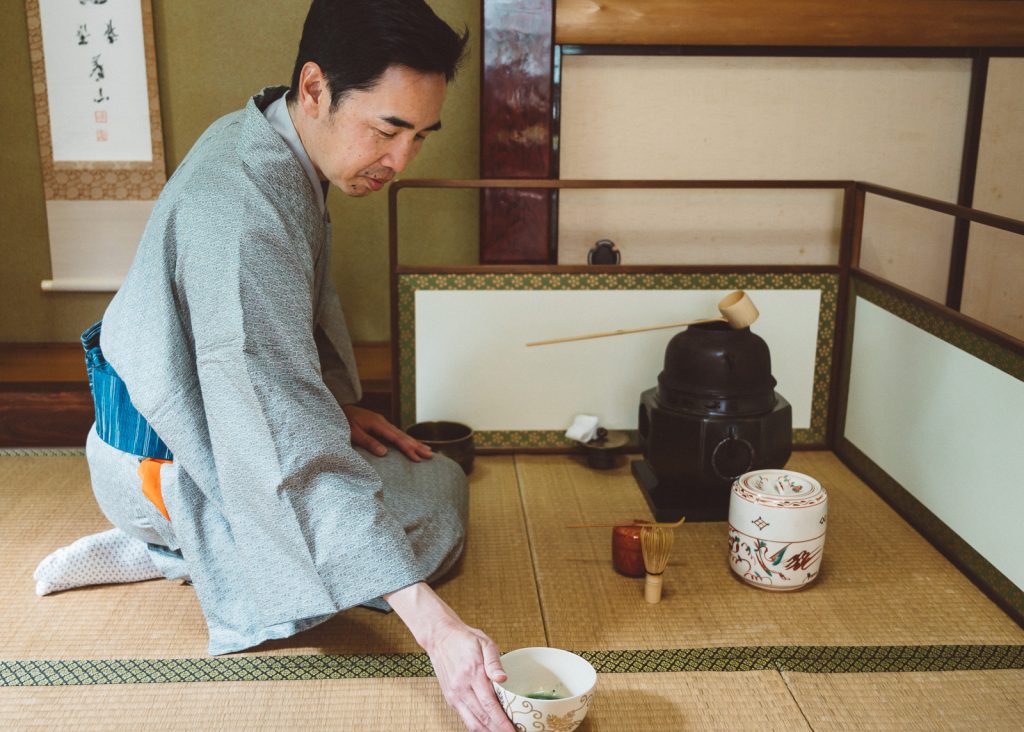
Todd Fong is an American freelance writer living in the greater Tokyo area. He has visited, written about, and photographed Iiyama City many times and considers it one of his favorite escapes from the big city.
The Japanese have a word for it: shinrinyoku, which translates literally into “forest bathing.” Call it shinrinyoku, forest therapy, or a rejuvenating walk in the woods, a growing list of scientific studies agree that this relaxing activity has positive health benefits. From reducing stress levels to boosting your immune system, the forest is more than just a pretty place—it is a place where humans can find wellness.
I came to Iiyama’s Nabekura Kogen highlands via Tokyo amidst the daily crush of commuters who, if you could catch their downward-gazing eyes, appear weary and lifeless. City folk like us need the forest, and fortunately, we can hop aboard a Shinkansen bullet train and be at nature’s doorstep in less than two hours.
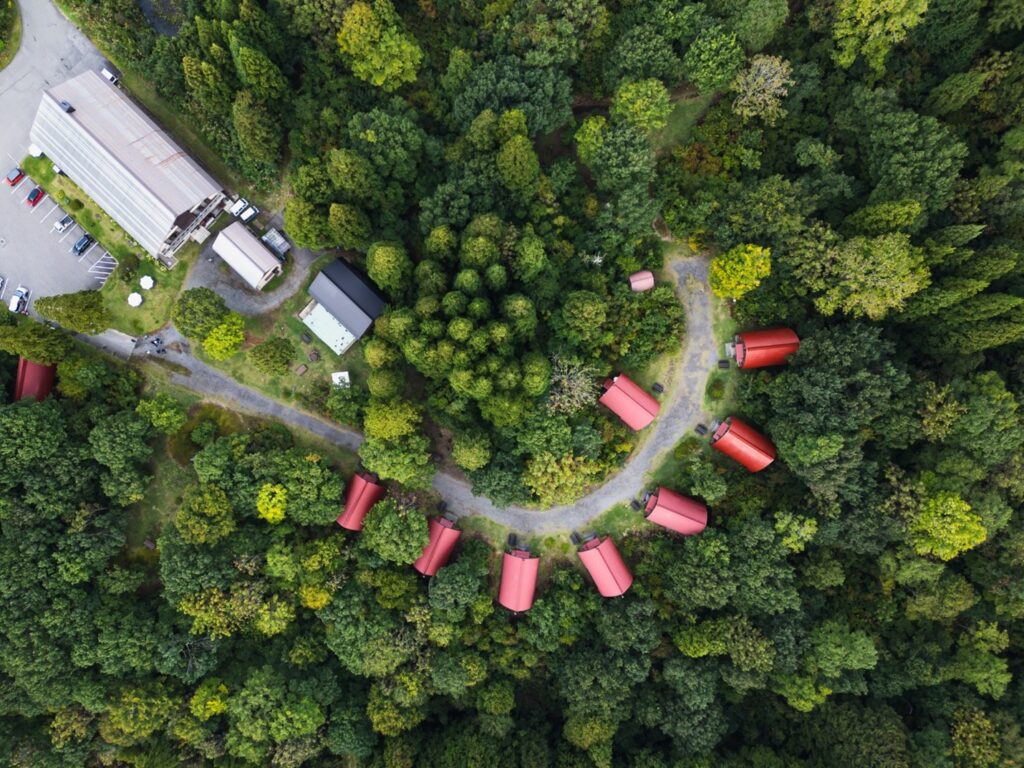
Mori no Ie: Enjoy Forest Bathing in the Heart of Nagano
Here in northern Nagano’s mountains, there are basically two seasons: snow season, when the heavy annual snowfall makes the area a wonderland for snow sports lovers, and green season, where the forests and farms are fed by the pure waters of melted snow, turning the mountains lush with natural beauty.
In the heart of this natural paradise, Mori no Ie provides the perfect facility to explore well-maintained forested trails of the Nabekura highlands and engage in forest bathing. Originally founded on the Japanese concept of satoyama, people living in harmony with their natural surroundings, Mori no Ie gives visitors from urban areas a chance to live rural life, if only briefly.
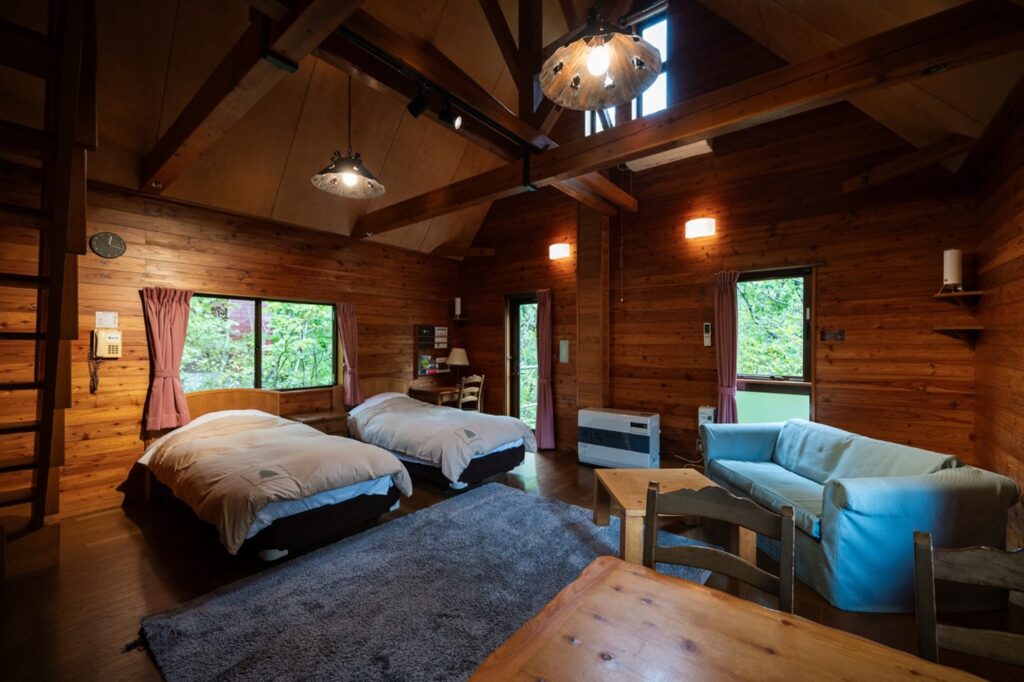
Mori no Ie is centered around a main lodge, providing a spacious lobby, concierge service, and a small shop. Accommodations are provided in 10 cabins on the property for up to 7 people, with Western (beds and sofa beds) or Japanese (futon on tatami mats) style sleeping arrangements. A 2-day, 2-night accommodation plan is the suggested way to engage in some downtime, with plenty of opportunities to enjoy the rejuvenating forest that surrounds the facility.
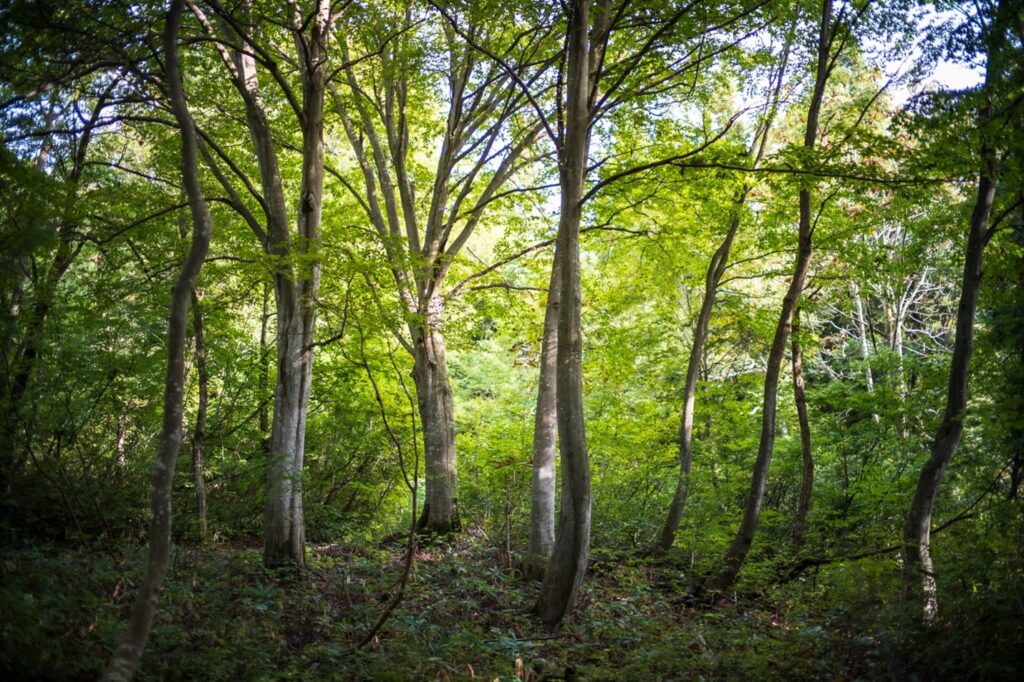
In fact, one of Mori no Ie’s many charms is its buna (beech) forest, an old-growth forest that has established itself within the surrounding cedars. Unlike their evergreen neighbors, beech trees explode into brilliant yellow hues in the autumn in dramatic contrast to their smooth white trunks. Lying bare under several meters of snow for the winter, the beech trees emerge again in spring with tender green leaves.
Shinrinyoku Forest Bathing with an Experienced Therapist Guide
I spent the afternoon of the day I arrived engaged in a form of shinrinyoku, forest therapy. Therapy requires a therapist, and that was Shimizu-san, a licensed forest therapist who has been leading these experiences for 26 years on top of his extensive experience as a forest guide. Shimizu began by explaining the science behind forest bathing; natural chemicals emitted by trees and other plants called phytoncides help protect from the effects of rotting or being eaten by insects. These antimicrobial chemicals have been found to protect humans in the same way they assist plants, fending off harmful bacteria, viruses, and fungi.
But phytoncides have also been shown to have a positive effect on NK-type white blood cells, which attack tumor and virus cells, leading to speculation that regular forest bathing might also help prevent some types of cancer.
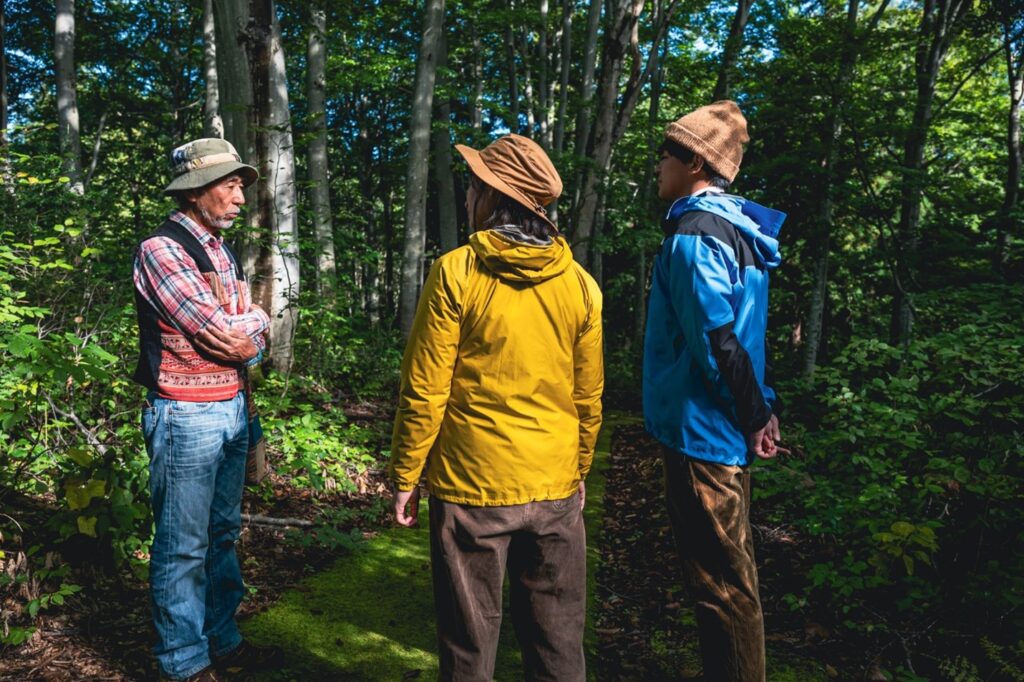
Therefore, said Shimizu, the key to getting the most potential health benefits from forest bathing is getting the most exposure to phytonicides. Teaching us simple breathing exercises to be mindful of our breathing patterns and fill our lungs with fresh forest air, he encouraged us to slow down and enjoy a leisurely experience among the trees.
Along the path, Shimizu shared tidbits from his deep experience as a forest guide. He offered us wild plants to taste, found hidden seeds among the fallen foliage, and pointed out which plants we shouldn’t touch at all.
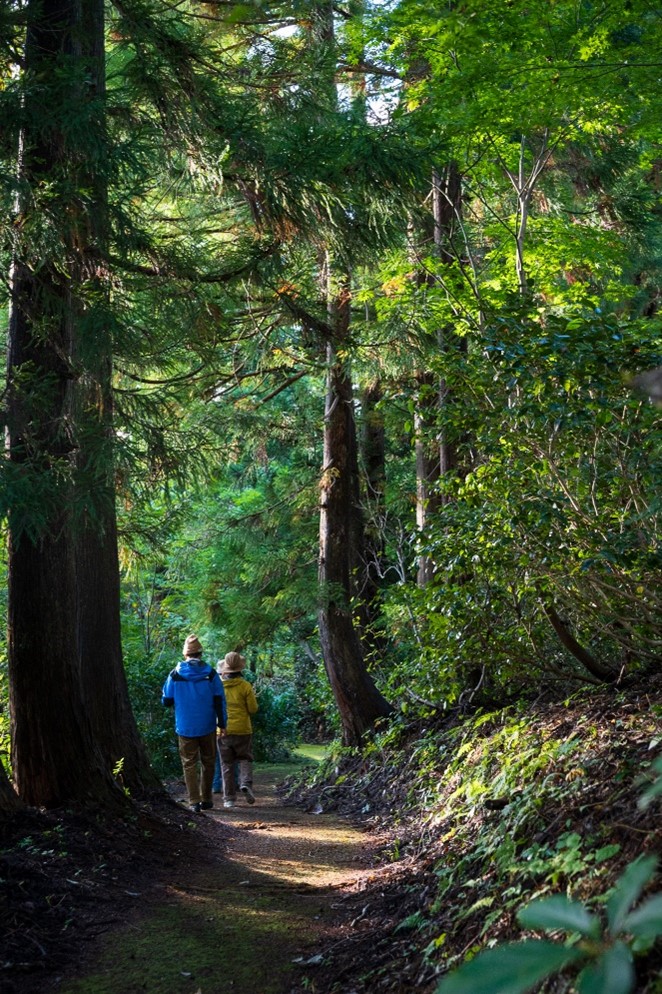
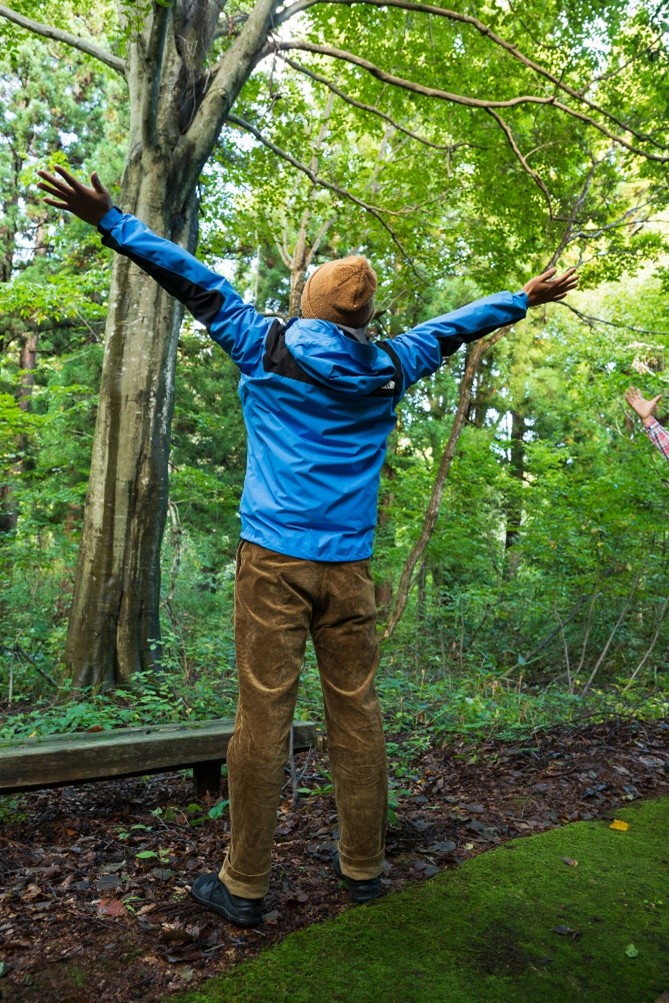
Among the beech forest, Shimizu presented our first exercise of the forest therapy experience: lying down under the trees. Ah, this is the type of exercise I could get used to. For 20 minutes, we lay on yoga mats, alternately staring up at the beautiful beech canopy and closing our eyes to listen to the sounds of the breeze and the call of birds in the forest. The urge to drift off to sleep was nearly overpowering, but you receive the most benefit by staying awake and mindful of the present.
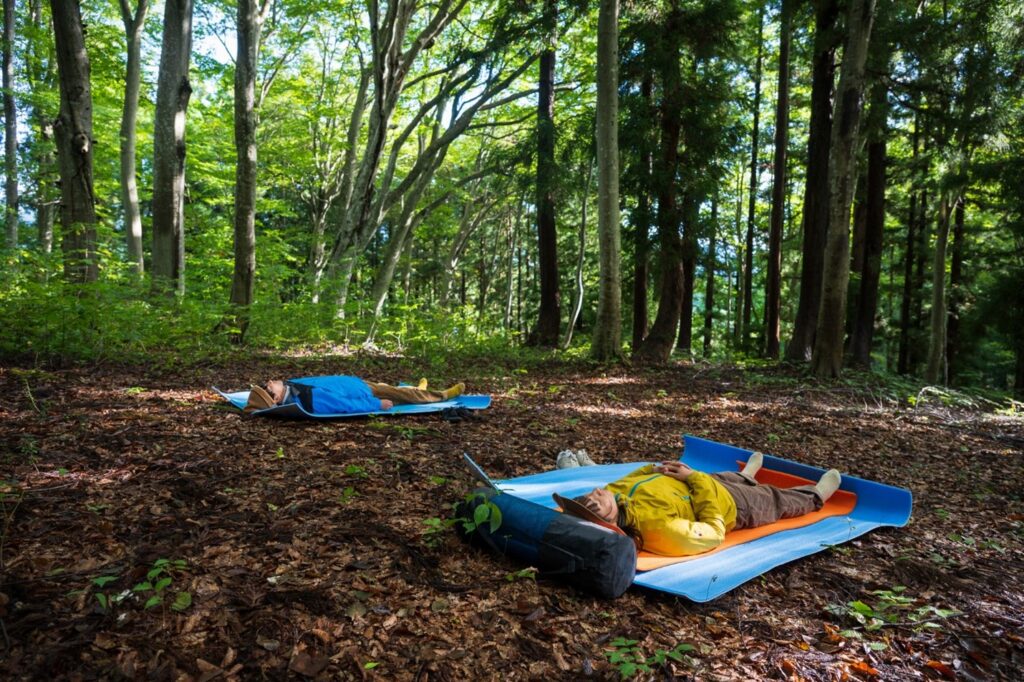
Near the end of the experience, we sat in camping chairs overlooking a quiet pond, eating some prepared snacks and sipping tree bark tea while we reflected on what we had received from the forest. I was surprised by how staying mindful of my natural surroundings rather than just mindlessly walking along the path completely changed my experience.
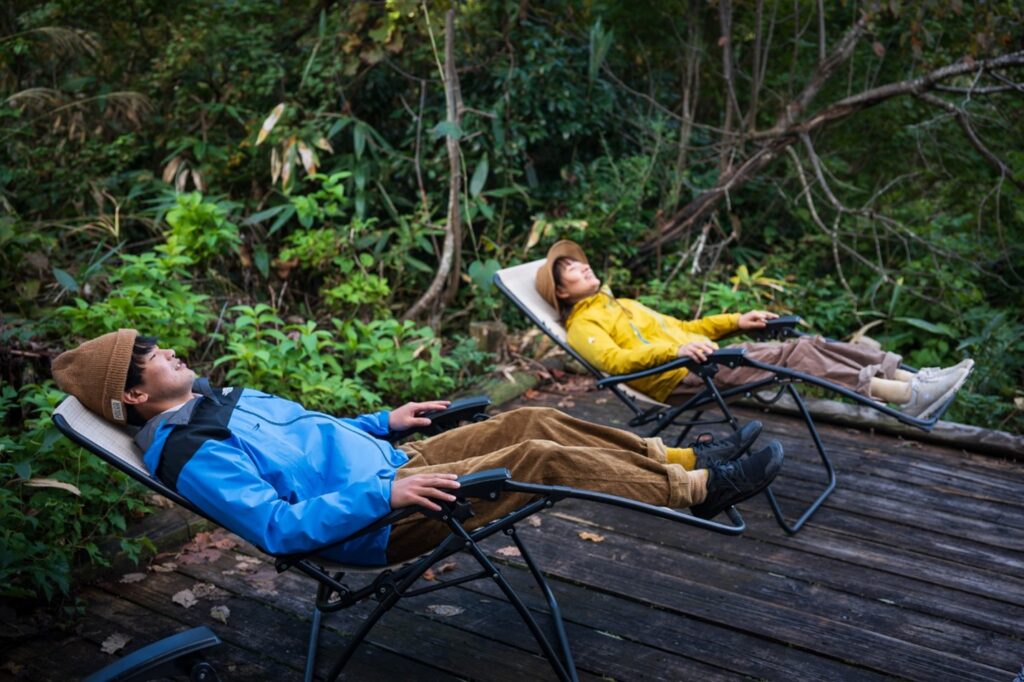
Okinawa-Inspired Cuisine and a Restful Night’s Sleep
After a brief rest in my cabin, the Mori no Ie staff took us to Paipatiroma, a charming restaurant in a renovated folk house nearby. The young family who runs it relocated to Iiyama a few years ago, bringing a fusion of Japanese izakaya dishes with an Okinawan twist. As Okinawan food is purported to contribute to the longevity of the people of the islands, it seemed fitting for us to enjoy some Okinawan dishes after our forest bathing experience.
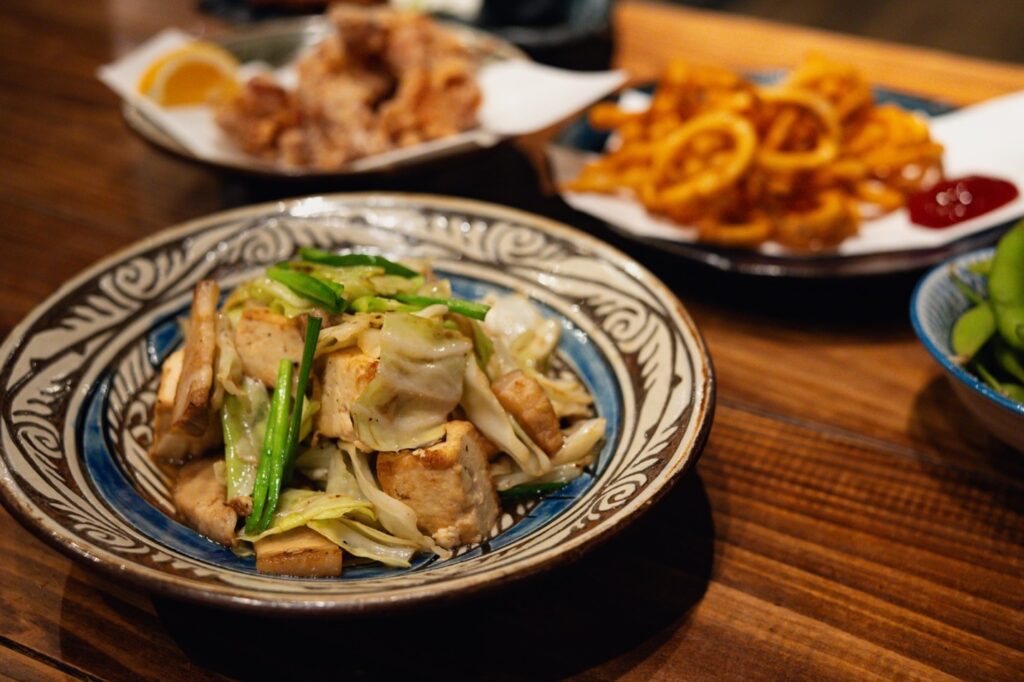
A full stomach and a half day experiencing the forest brought an easy sleep that night. After spending a bit of time gazing up at the billions of stars visible in the clear night sky above us, I retired to my cabin for one of the best night’s sleep in recent memory.
Day 2 Options: Forest Bathing Hikes or Organic Herbal Tea Experience
The second day is a flexible one for most visitors. Some would like to apply their new-found knowledge of forest bathing to a more extended hiking experience in the woods on their own (just don’t try to eat anything you find without a professional guide). Mori no Ie also has bicycles available to rent if you’d prefer to explore roads and trails further afield on two wheels. I opted for an optional experience at nearby Higurashi Farm: making my own organic herbal tea from the farm’s herb garden.
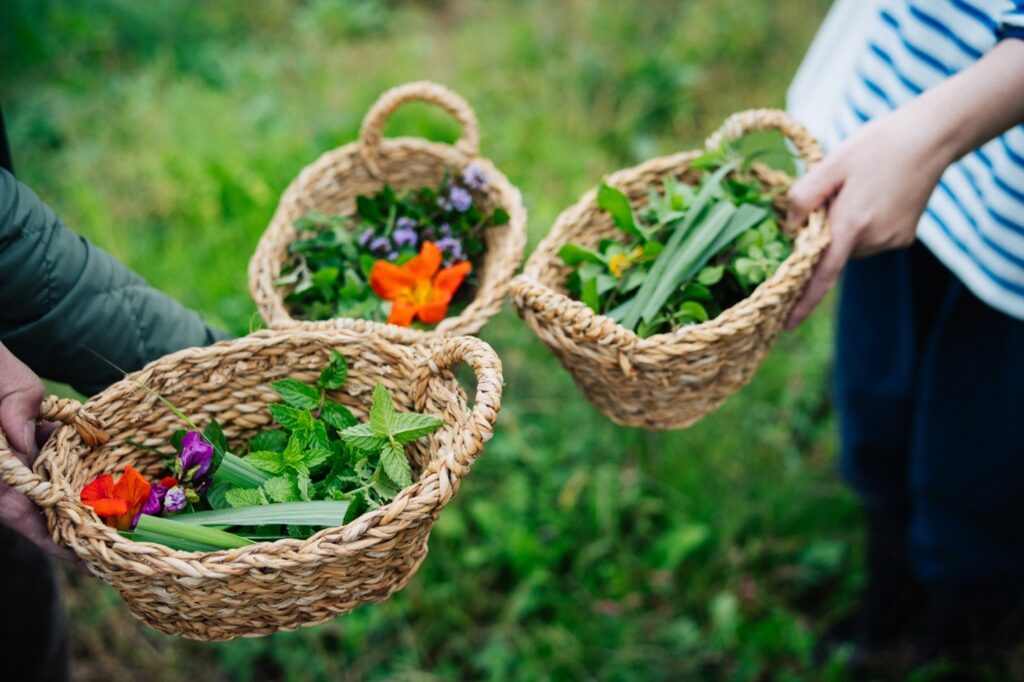
Mami Kiuchi conducts the herbal tea experience on the farm owned by her family, located in the foothills just above Mori no Ie. Although the farming season is short due to the heavy annual snowfall, the fertile soil produces some of Japan’s best-tasting fruits, vegetables, and apparently herbs as well.
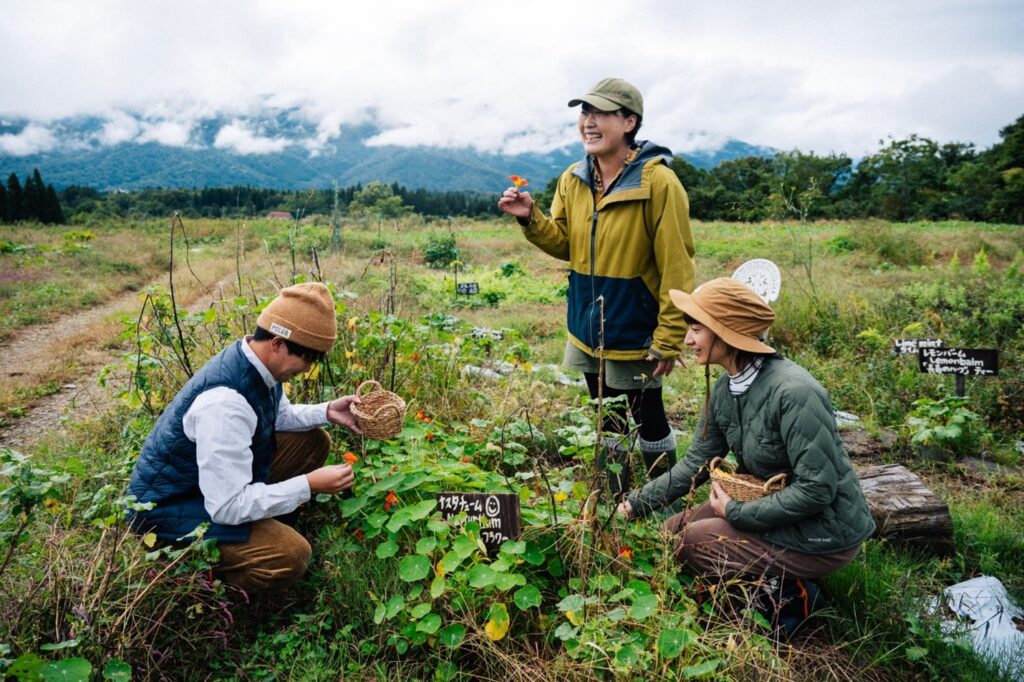
Mami’s decision to grow herbs on her family farm is a deeply personal one. Diagnosed with lupus several years ago, she spent three months in the hospital. During her stay, she began researching different methods for managing her health condition and learned about the benefits of some herbs. Continuing her research, she learned herbal remedies have been used for centuries to treat and prevent various ailments. So the seeds of her herb garden were planted, literally and figuratively.
The first step is to select a few types of herbs from Mami’s garden; not too many, or it won’t be easy to discern the different flavors in the tea. From her locally famous fennel to the unusual (banana mint, anyone?), narrowing your selection is the most challenging part of the process.
After giving the herbs a quick rinse (no washing is necessary, as the farm doesn’t use pesticides or chemicals), we’re ready to brew the tea in a standard French press.
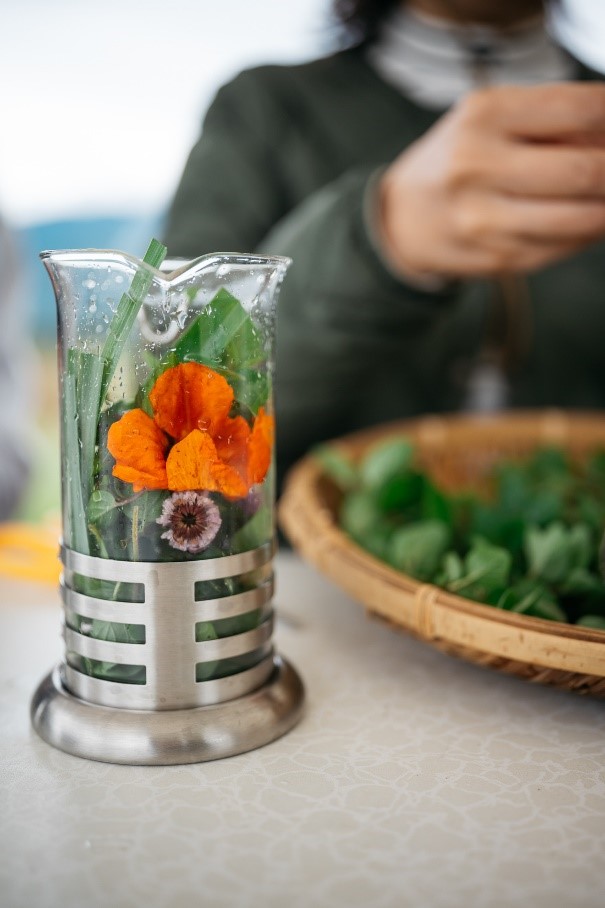
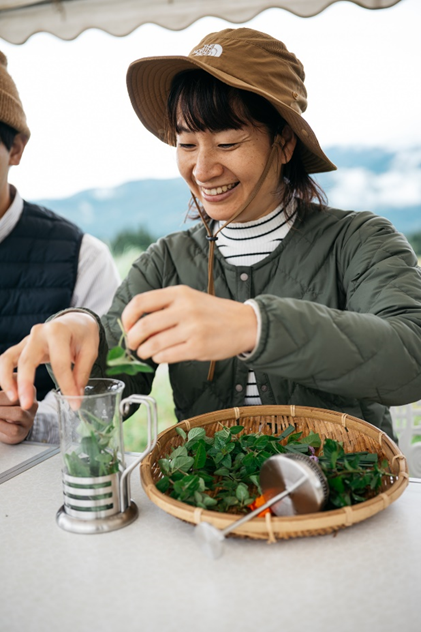
The herbs are steeped in the hot water for 3 to 5 minutes, allowing the subtle flavors of the plants to permeate the liquid. The water also gains a slight tint, green for some herbal combinations while golden for others. While we anxiously await, Mami-san serves some cookies she made with colorful herbs mixed into the dough.
Sipping our tea, we watched the fog creep slowly over the mountains above Nozawa Onsen on the opposite side of the Nabekura Kogen. It was lovely to be here on a cool autumn day, enjoying tea time and conversation with one of Iiyama’s many colorful residents. The herb tea experience is available only during a limited time of the year, generally from summer to mid-autumn, when the herb garden is at its prime.
More Activity Options from Pizza Making to Onsen Hot Springs Relaxation
In the afternoon, more choices await at Mori no Ie. You can spend your free time exploring the forest or taking a relaxing nap in Mori no Ie’s “Hammock Forest,” where hammocks hang between the trees in a beech forest, and you can hear the sound of a nearby running stream. You can also choose to create your own pizza in the outdoor brick ovens at Mori no Ie, with fresh vegetables picked from Higurashi Farm (also a seasonal experience, generally from late summer to autumn). Or, if you prefer a more traditional Japanese method of relaxation and rejuvenation, the staff will drive you to nearby Yutaki Onsen, where you can enjoy indoor and outdoor hot springs baths and a traditional Japanese tonkatsu (breaded pork cutlet) meal made with local products.
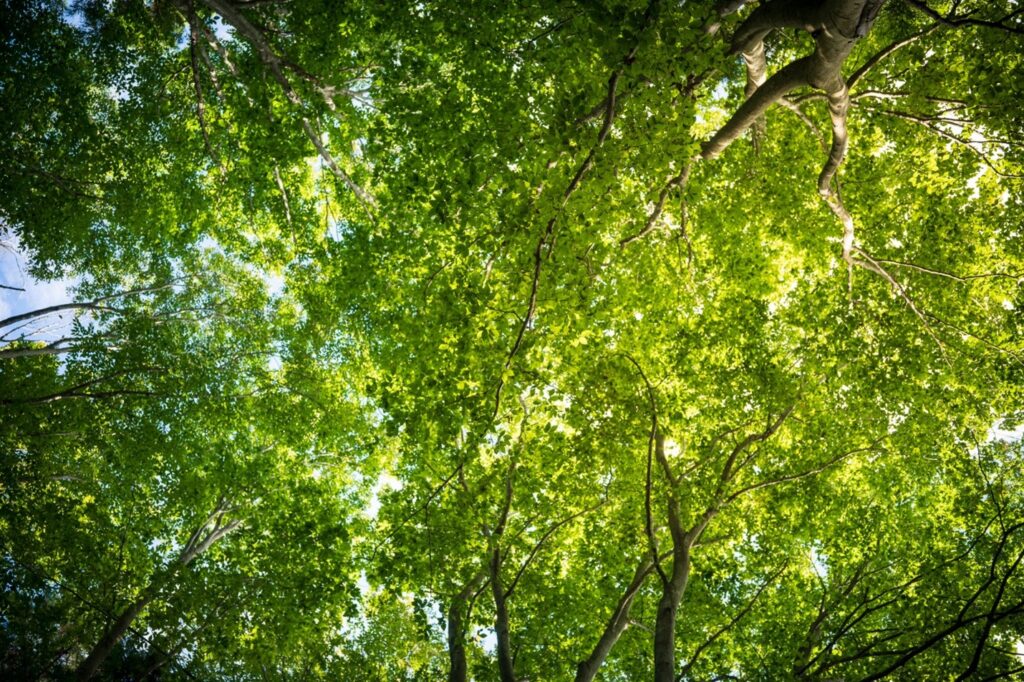
More Refreshing Experiences in Iiyama’s Green Season
Two days of forest bathing in a lush forest, enjoying herbal remedies at an organic farm, and getting a perfect night’s sleep in a secluded cabin may only serve to whet your appetite for what the Iiyama area has to offer. Spiritual adventures at ancient shrines and temples, taking a cycling tour along the peaceful Chikuma River, and hiking the Shin-etsu Trail, a 110-km long scenic hiking trail between Nagano and Niigata, are a few other ways to enjoy Iiyama’s Green season, to say nothing of the Winter sports and activities available once the snow begins to fall.
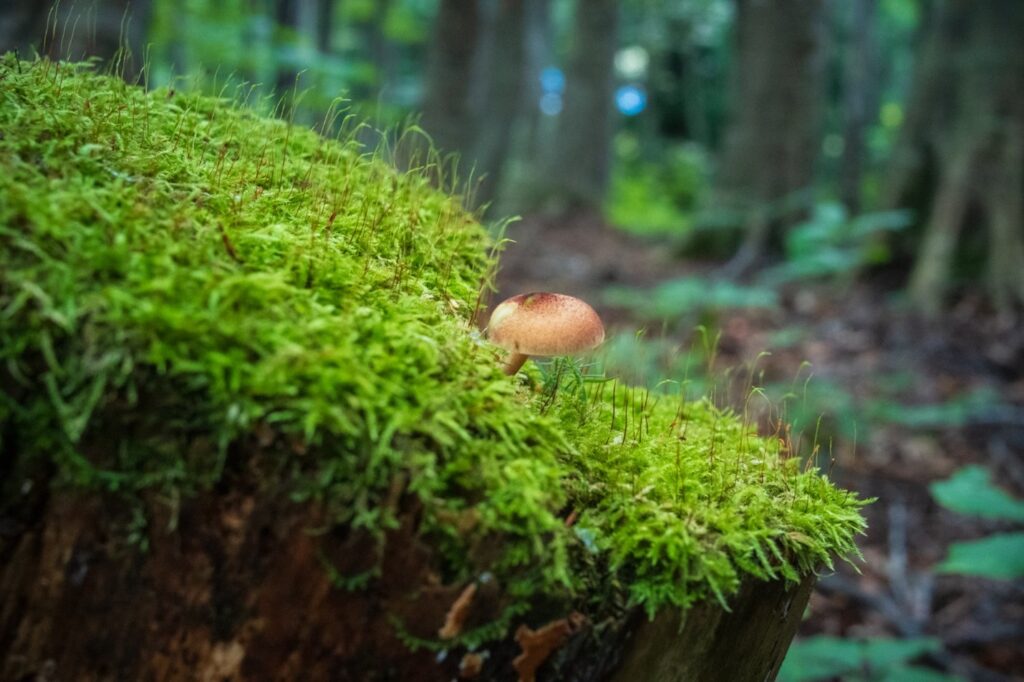
Just 90 minutes from Tokyo on the Hokuriku Shinkansen bullet train, Iiyama is a convenient location for a digital detox or a couple of days spent in refreshing nature, whether for forest bathing or outdoor adventure. Come and spend some time here, and you may find yourself, like me, returning again year after year.



